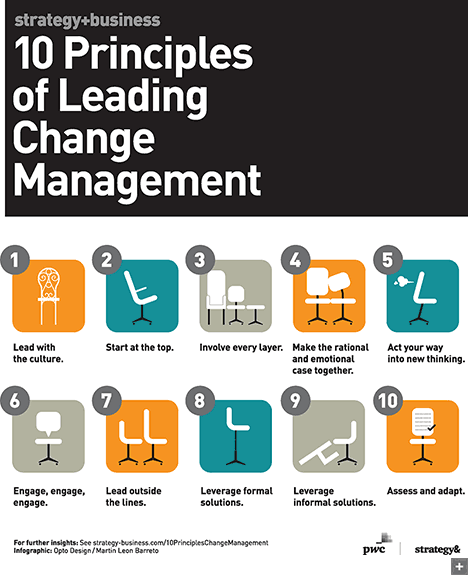It is human nature to resist change. However, to keep up with a constantly evolving marketplace, organizations must be adaptable and growth-oriented. To quell the resistance that inevitably accompanies transformation efforts, a few change management exercises could go a long way.
What is a change management exercise?
Change management exercises are games or simulations that motivate employees to accept change and actively engage with the change process. When posed in a positive, zero-stakes setting, these exercises minimize resistance and make change a fun event.
The exercises below are just a few examples of activities that will get employees excited about upcoming change.
1. Cross Your Arms the “Other” Way
Gather employees and ask them to cross their arms. Then, once they are comfortable in that position, ask them to fold their arms the other way. It feels quite different, doesn’t it? Despite the fact that they are only making a slight change to their stance, the feeling is not the same.
Ask your employees to discuss how this small but noticeable change makes them feel. For some, the unfamiliarity of the posture might be frustrating. Or, it might just be a bit uncomfortable. However, the longer they sit with their arms this way, the more comfortable they’ll become. Relate this feeling to how an organizational change can feel wrong at first, but begins to feel more natural as time goes on.
2. The Alien at Dinner

In this game, employees pretend that they are an alien sitting at a human dinner party for the first time. While observing the humans around them, the alien employee is asked to note the odd behavior that the humans exhibit while they eat and talk to one another.
This exercise demonstrates to employees the importance of diversity in thought, keeping an open mind, and really considering others’ ideas. It helps people learn to question what they have long accepted as normal. Change management exercises like this help staff become more comfortable with assessing how things are done now and how they can be improved.
3. Changing Places
Arrange chairs in a circle and place an object in the center. Ask employees to take a seat, then observe the object. After a minute or so, ask them to get up and change seats. Call on them to describe the object from their new point of view. Then, tell them they are allowed to get up and change seats once more.
Some employees will wish to stay put. However, staying in the same place limits the number of perspectives that they can have. In contrast, each time the employees observe the object from a different perspective, they have the opportunity to notice something new. Change management exercises that illustrate the importance of gaining a new perspective help mollify resistance and show how a change can be beneficial.
4. The Ups and Downs of Change
Create a list of change-related words, such as “transformation,” “implementation,” “transition,” “training,” “process change,” and more of the like. Read different words aloud and ask employees to step forward if the word evokes a positive response, backwards for a negative response.
After each word, have employees observe the changes in the room and discuss why they chose to step forward or backward. Those who stepped backward may have a stronger tendency to resist change, or at least associate negative emotions with change. Open a dialogue about how thinking of change-related terms in a positive way will actually help them get them farther.
5. The Four P’s
With a large sheet of paper or board, create four columns labeled with each of the following words: Project, Purpose, Particulars, and People.
Ask the group to fill out each column depending on how they believe a given change will affect those four entities. By asking employees to articulate their concerns about how a change will affect certain things, change managers can more effectively address their apprehensions. Discussing these concerns will help employees gain a better understanding of the true effects of the change and reduce resistance.
6. Bounce Back

Ask your employees to pair up. Then give each pair a rubber ball and ask them to bounce it back and forth. After a few minutes, ask the group if they were ever concerned that the ball would not bounce up after they tossed it to the ground.
Just like a bouncy ball, organizations will rebound from the challenges produced from change. Change management exercises such as this encourage employees to embrace the movement and understanding that they will recover afterwards, even if a change is uncomfortable at the moment.
7. Can-Do Company
Split the group of employees into teams of 5 or 6 and ask them to come up with a simple, fun business idea that they will present to the entire group. Give each team member a role like planning, design or sales.
After letting the groups strategize for 10 minutes, move a few participants from each group around to other groups. Then introduce one new criterium the business idea must contain. Allow the groups to strategize for another 10 minutes, given the new information. At the end of the session, each group presents their idea and everyone votes on the best one.
This exercise demonstrates the importance of being flexible during the planning process. It simulates the need to work as a team, even amid changes to the team itself, and embracing others’ ideas. After, ask the employees to reflect on what good things came out of having a new perspective on the team. How did the end product change from that first round of planning to the second?

Credit: Strategy+business
How do change management exercises look today?
Due to the current climate of COVID-19, most workplaces are closed and employees are working from home. Managers are now tasked with leading teams remotely which requires increased communication and clear expectations around work performance.
Coping with change and empowering employees to rise to the occasion is now more important than ever. As many organizations are finding their footing amidst this sudden shift, embracing change management can maintain business continuity and give employees an engaging way to handle new processes that might come their way.

Change management exercises for remote workers
In light of the present situation, below are two change management exercises that can be done via Zoom with your team to empower them to deal with more unknowns during this period and beyond.
Draw, draw draw
Gather your team on a video call and instruct them to have paper and pens ready. Preface the exercise by saying that drawing skills are not being measured, and each employee should concentrate on simply completing the task.
The manager will begin with an instruction to have everyone draw a house. After a couple of minutes and before the picture is completed, the manager will say that they changed their minds and now want a picture of a boat. Again, at some point before everyone finishes, the manager will change the directions and tell everyone to draw a castle. As the manager keeps changing their mind, employees might begin to feel a bit fed up. After a series of changes, and before engagement is lost, the facilitator should start a conversation about what everyone experienced.
This exercise highlights the frustration that change can elicit and the negative behaviors associated with having to make something new each time from scratch. This is a great way to have employees look critically at which points during the exercise they became frustrated and why. The conversation can broaden to address where sudden pivots have been made at work, how employees rose to the challenge and how making that change inspired innovation or an improved way of doing things.
Signature for change
Ask all employees on your video conferencing call to sign their name 10 times on a piece of paper. This should take a minute, and promptly afterward, ask them to do it again. Once they’re done, instruct employees to put the pen in their other hand and do ten signatures, and then repeat.
Initiate a conversation about how hard signing their name was using their opposite hand and any challenges that arose.

Now ask them to sign their signature again 10 times. Most people will use their usual hand, but why did they switch back? The instructions didn’t change. The point of the exercise is to demonstrate how difficult change can be, and most people will revert to what they know unless they are making a concerted effort to implement change.
Change Management in Action
Change management exercises help employees more easily acclimate to something new. Even though our natural instincts tell us to resist, embracing change can actually result in a much happier and productive workplace.
When company leadership stays active in promoting change, employees will stay on board and be motivated to actively pursue new challenges.





